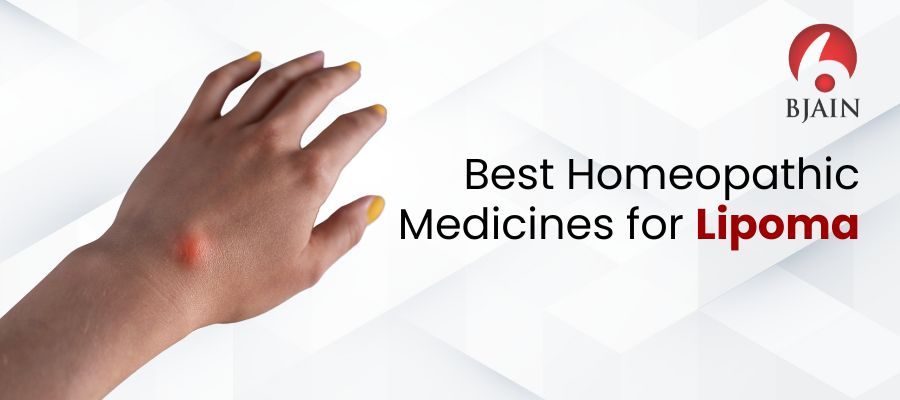We see many people troubled with the accumulated masses under their skin. It is a common issue that may trigger panic among people as it might seem cancerous. This is the reason behind the careful handling of such cases. As more individuals seek comprehensive and non-invasive answers to their health problems, homeopathy becomes increasingly obvious giving a potential option for those seeking a more natural approach to lipoma care. In this article, we will look at lipomas, why they occur, and the area of lipoma therapy in homeopathy.
A lipoma is a circular or oval tissue mass immediately below the skin. It is composed of fat, moves readily when touched, and rarely causes discomfort. Lipomas can develop anywhere but are most commonly found on the back, trunk (upper body), arms, shoulders, and neck.
Lipomas are benign soft tissue growths. They develop slowly and are non-cancerous.
What are the causes of Lipoma?
Healthcare practitioners don’t know how people get lipomas to develop. They are inherited (or handed down via generations). If you have a family history of lipomas, you are more likely to get one.
Certain causes induce numerous lipomas to occur in the body. The following conditions can cause lipoma:
- Dercum’s illness is an uncommon ailment in which painful lipomas form on the arms, legs, and trunk.
- Gardner syndrome is a kind of illness known as familial adenomatous polyposis (FAP), which produces lipomas and other health issues.
- Hereditary multiple lipomatosis, also known as family multiple lipomatosis, is a genetic condition.
- Madelung’s Disease: This disorder is particularly common in males who drink alcohol heavily. Also known as multiple symmetric lipomatosis.
What are the symptoms of Lipoma?
Lipomas are typically painless, although they can be irritating if they push on a nerve or form near a joint. Many patients with lipomas do not experience any symptoms. Lipomas are typically:
- Encapsulated: They do not disseminate to the tissues around them.
- Painless: Some lipomas induce pain and discomfort based on their position, size, and the presence of blood vessels.
- Spherical or oval-shaped: The fatty masses of elastic tissue are often symmetrical.
- Moveable: They lie just below the skin’s layer and move when touched.
- Lipomas are typically less than two inches in diameter, while they can occasionally grow greater than 6 inches.
Does Lipoma run in families?
Lipomas are inclined to run in families, which suggests that genetics play a part in their formation. In fact, having a family member with a lipoma increases the likelihood of developing one oneself.
Familial multiple lipomatosis is a genetic adipose tissue condition defined by the development of many lipomas with a specific distribution. Lipomas are well-encapsulated, gradual in development, and benign fatty tumors. The distribution is characterized as being concentrated in the upper part of the body and the extremities. Familial Lipomatosis is defined as the presence of several lipomas in multiple relatives throughout several generations. Some persons could have hundreds of lipomas.
What are the best homeopathic medicines for Lipoma?
Some of the homeopathic medicines that can be used in the management of Lipoma are:
Belladonna: Lipomas are mostly painless, but they can also be painful. In some cases, touching the bump aggravates the agony. Belladonna not only relieves pain but also helps with complete dissolution in such conditions.
Calcarea carb: It is the most effective drug for managing lipoma in overweight individuals. Before providing this medication, certain signs and tests must be evaluated on the patient. Before prescribing this remedy, three factors are evaluated: excessive perspiration via the head, vulnerability to cold air, and unique eating patterns such as a yearning for a specific type of food. Other than these three indicators, which are the most important to evaluate, it is also determined if someone experiences constipation or acidity.
Sulphur: Sulphur is the next therapy option for lipomas. In truth, sulphur and calcarea carb are equivalent. Yet, it still has to be determined which drug is most suited to each individual based on their constitutional makeup. Patients with high sugar consumption, profuse perspiration, sensitivity to heat, and a dislike of washing are the ideal candidates for giving Sulphur for lipoma.
Thuja occidentalis is commonly used to treat painful or sensitive lipomas due to its skin-friendly properties. It is also recommended when several lipomas are present.
Lycopodium clavatum is used to treat difficult and painful lipomas. It is also appropriate for people who have digestive problems, such as gas and indigestion.
Silicea is widely used to treat hard lipomas with underlying infections. It is thought to increase the body’s immunological response.
Phytolacca decandra is recommended for painful lipomas that feel entrenched in the tissues. It is also used when you have swelling or soreness.
How can you manage your Lipoma?
On top of homeopathic treatment for lipomas, a variety of dietary and lifestyle changes may assist in minimizing the size and discomfort of existing lipomas while also preventing new ones from developing. These modifications include:
- Consume a balanced diet high in plant-based foods. These foods are high in antioxidants along with other substances that can boost immunity and decrease swelling.
- Avoid processed foods that are high in sweeteners and bad fats. Processed foods are frequently filled with sugar and harmful fats, which can lead to swelling and obesity.
- Consume a lot of water during the day. Water helps the body wash out toxic substances and stay hydrated.
Homeopathy approaches lipomas holistically, prioritizing the patient’s total health and well-being. Medicines like these can help to ease symptoms and reduce their development. As with any medical procedure, consulting with a knowledgeable specialist is vital in determining the best plan of action. Following homeopathic ideals, which treat the root cause of diseases, facilitates a thorough healing process. Patients must approach homeopathy with persistence, recognizing that it is a progressive procedure that focuses on long-term healing.
Frequently Asked Questions (FAQs)
Q. How do you get rid of a lipoma?
Ans: You can get rid of all types of lipomas with the help of holistic homeopathic treatment. It can help balance the underlying imbalances and even make your body resistant to repeated presentation of lipoma.
Q. What size lipoma should be removed?
Ans: Any size lipoma can be managed with homeopathic treatment. The size, shape, location, and presentation of a lipoma are taken into consideration during homeopathic treatment. Complete individualized history of any disease is the essence of Homeopathic principles.
Q. Which treatment is best for lipoma?
Ans. Homeopathic treatment should be considered the best option for the management of lipomas. It does not only help relieve the associated complaints of lipoma but also helps reduce the further occurrence of lipoma.

Dr Kiran Swami
Dr. Kiran Swami, BHMS, MD (Hom.), a Research Officer at BJain Pharmaceuticals Pvt. Ltd., holds degrees from Nehru Homeopathic Medical College, Delhi, and Dr. Sarvepalli Radhakrishnan Rajasthan Ayurved University, Jodhpur. With expertise in homeopathy and a passion for research, she drives innovation in holistic healthcare solutions.


